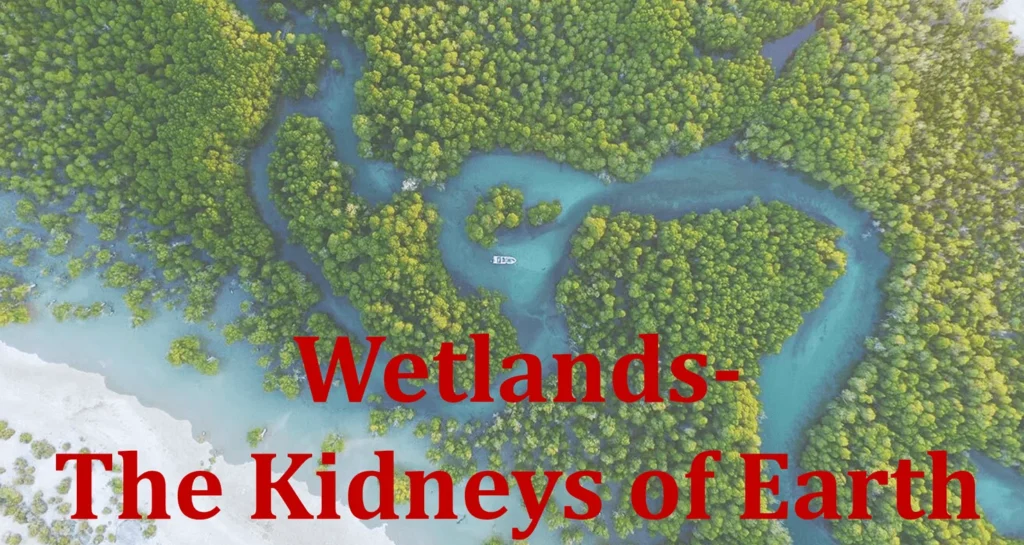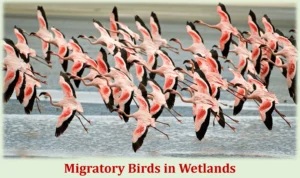
Wetlands are beautiful ecosystems that are on the border between land and water and are extremely important ecologically. There are unique locations on the earth where land and water converge, they are termed as wetlands. The natural features such as marshes, swamps, bogs and estuaries fall under the category of wetlands. Each among these have distinct characteristics with a wide variety of flora and fauna. In this article I’ll discuss the value of wetlands and the problems they currently face. This article will further focus on how they are home to number of species and why they are called “The Kidneys of Earth“.
What are Wetlands?
They are transitional zones between terrestrial and aquatic environments, characterized by the presence of water either permanently or seasonally. They act as an important reservoir of biodiversity. The support an incredible variety of species that ranges from microorganisms to large mammals.

Types of Wetlands
- Marshes: Characterized by emergent herbaceous vegetation, marshes are frequently inundated with water. They can fall under any of these categories i.e., freshwater, saltwater, or brackish.
- Swamps: Dominated by woody vegetation like trees or shrubs, swamps are often flooded and support a rich diversity of flora and fauna.
- Bogs: These are acidic wetlands characterized by the accumulation of organic matter in waterlogged soils. Sphagnum mosses and other specialist plant species, such carnivorous plants, are frequently found in bogs.
- Estuaries: Found at the interface of rivers and oceans, estuaries are semi-enclosed bodies of water where freshwater mixes with seawater. For a variety of fish species, they serve as both breeding and feeding areas.
Ecological Functions of Wetlands
- Keeping Away Floods: Wetlands are like natural sponges. They act as barrier to prevent the floods keeping the people safe. They are able to do so because they soak up additional water when it there is heavy rainfall.
- Cleaning Water: Wetlands have lots of plants, tiny creatures, and special soil that clean water. They take away extra stuff in the water, like dirt and chemicals. So, the water that comes out of the wetland is cleaner and better for everyone.
- Giving Homes to Many Animals and Plants: Wetlands forms a natural home to number of species including animals and plants. Fish use wetlands to have babies, birds make nests there, and baby frogs and other small creatures grow up in wetlands.
- Helping with Climate Change: They are really good at grabbing carbon and carbon is a big part of what makes climate change happen. Additionally, they stop the carbon from turning into something called carbon dioxide, which is not good for the environment.
- Fun and Learning: They forms a unique destination for both tourist and researchers. Moreover, you can also locate number of wildlife photographers ready to click some beautiful images of birds. Wetlands are also good spots to learn about nature and a place to relax the tired minds.
So, wetlands are like nature’s friends, doing lots of important things for the world. This why they have been termed as “The kidneys of Earth”.
Biodiversity Hotspots
Wetlands forms one of the most diverse places on the earth where number of different species of both plants and animals reside in a symbiotic relationship. They are homes to lots of creatures, like:

- Birds: They are important resting spots for birds that travel long distances. They stop here to eat and rest during their big journeys.
- Fish: Many fish species rely on wetlands for breeding and foraging. Some, like salmon, depend on both freshwater and estuarine wetlands.
- Amphibians: Frogs, toads, and salamanders are highly adapted to wetland habitats, using them for breeding and shelter.
- Invertebrates: They are full of Insects, crustaceans, and mollusks. Moreover, each of these species have different role to play and contribute to the environment in their own way.
Threats to Wetlands
Despite their ecological significance, they are facing numerous threats, including:
- Urbanization: The conversion of wetlands into urban areas and agricultural land has led to their drastic decline.
- Pollution: Runoff from urban areas, industrial facilities, and agricultural lands introduce pollutants that can harm wetland ecosystems.
- Climate Change: Rising temperatures, sea-level rise, and altered precipitation patterns are impacting wetlands and their associated species.
- Invasive Species: Non-native species can outcompete and displace native wetland species, disrupting the delicate balance of these ecosystems.
Significant Steps Taken to Protect Wetlands
Here are some significant steps that have been taken to safeguard wetlands:
Ramsar Convention on Wetlands
In 1971, many countries agreed to a big international rule called the Ramsar Convention. It has turned out to be the most significant in preserving wetlands. More than 170 nations registered for it. All the member nations have decided to protect them and utilize them in a sustainable way. The Ramsar Convention also picks special wetland places from around the world and calls them ‘Ramsar Sites’ because they’re important for everyone.
Legislation and Regulations
Many countries have enacted laws and regulations specifically aimed at wetland conservation. Provisions for wetland preservation, restoration, and sustainable management are frequently included in these legislative systems. For instance, the Clean Water Act in the United States controls the release of contaminants into wetlands.
Wetland Conservation Organizations
Numerous organizations and NGOs focus on wetland conservation and restoration. No matter whether these groups are big or small their efforts cannot be neglected. They all work in collaboration with governments and communities to keep wetlands safe. Some groups you might have heard of are The Nature Conservancy and Wetlands International.
Wetland Restoration
Efforts are made to restore degraded or damaged wetlands to their natural state. Sometimes, people have to do things like taking out bad plants, fixing the water flow, and planting the right kind of plants again in wetlands. All these steps taken by them makes them healthy.
Public Awareness and Education
Educating the public about the value of wetlands is essential. Sometimes, there are programs and places like nature centers that teach people because wetlands are important. They also educate the people to be careful towards wetlands and strive to protect them.
Learning About Them
A continuous effort from scientists and researchers to monitor the health of wetlands are taken. They are always working to find out new ways to maintain and improve the health of these lands.
Sustainable Land Use Planning
Encouraging sustainable land use practices around them is key to their protection. Planning for land use and zoning can assist stop agribusiness and urban growth from intruding on wetland regions.
International Partnerships
Collaborative efforts between countries and international organizations are instrumental in addressing transboundary issues. A large-scale collaboration is needed for shared water resources including routes of migratory birds and other variables.
Community Engagement
Engaging local communities in wetland conservation is vital. Local communities are blessed with the traditional knowledge and their close relation to these lands. Involving these communities on will surely increase the success rate of these conversation initiatives.
Climate Change Mitigation
Recognizing the role wetlands play in sequestering carbon, efforts are being made to incorporate wetland conservation into climate change mitigation strategies. After all, taking care of wetlands helps make less bad air stuff (greenhouse gases) and helps us deal with climate change such as global warming etc.
They require saving, and it will take everyone’s assistance. Consequently, people have agreed to participate from all around the world for which number of laws have been passed. Further, they have done well to educate the public about the importance of wetlands. All these steps will collectively ensure the safety of wetlands.
Conclusion
They are very crucial element of the earth and environment. They are abode to many species of plants and animals. Undoubtedly, they are also the protective shield for human civilization as they prevent floods and do other really important jobs. They are delicate but tough, so we should look after them if we want them to stay healthy for our kids and their kids. But, if each individual of the earth learns about their significance and decides to protect them, the earth will automatically become a safe place to live and for the generations to come.
